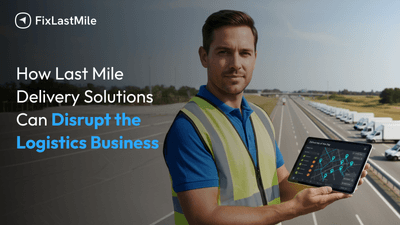A hungry customer is an angry customer.
People opt for takeaways because they want their meals now or at least at some times.
This fact has put enormous pressure on the delivery men to fulfill their orders at lightning speed.
However, considering the number of roadblocks such as traffic jams and unpredictable weather conditions, it does become difficult for deliverymen to reach customers faster.
Ultimately, it takes a toll on the food delivery business.
To avoid such situations and overcome the obstacles that businesses face daily, we have prepared this blog.
This blog will shed light on the challenges online delivery startups face and how adopting route optimization software is the solution.
What are the Challenges Faced by Online Food Delivery Startups?
In the overcrowded ecosystem of online food delivery businesses, there is a number of problems for food delivery startups. As the on-demand business model can be applied to any niche, its popularity has peaked in the transportation and food industry.
Sensing the lucrativeness of the online business, there has been an advent of a large number of food delivery startups, striving to serve the customers right. However, some of these challenges haven’t been resolved yet.
Below are some of the crucial challenges:
1. Logistics Dilemma
The dependency of a food delivery business is based on two aspects: food and delivery. Lack of adequate planning can delay the functioning of a business.
A restaurant is the beginning node of the business, and so, a delay in the preparation of the order can’t be tolerated.
However, in a much broader picture, the delivery service lies at the end of the node, and so, when there is any delay from the restaurant’s end, delivery men have to cope with the time.
Read More: How last-mile delivery solutions can disrupt logistics business?
2. Fickle-minded Customers
Nowadays, customers demand speed and accuracy; just offering discounts or good food is considered “bare minimum”.
That is why ‘fast delivery’ is what can win your business a loyal customer base. If you are offering them their food in a time-efficient manner, you can retain them.
So, opt for a last-mile food delivery software to offer convenience to your customers.
3. Handling Delivery and Logistics
The last-mile delivery may just seem as simple as picking up the order from the restaurant and delivering it to the address.
However, there are a lot of things playing a crucial role. For example, you may have 150 delivery men spread all across the city.
Let’s say a customer orders a dish and you have a deliveryman waiting just outside the restaurant. However, your system does not detect this person and sends a request to a person at some distance.
In such a scenario, the decision-making process of handling the delivery and logistics is based on assumptions and no real-time data. This leads to unnecessary delays.
4. Multi-order Delivery Conflicts
When a driver is assigned multiple orders at once, deciding which order to drop first becomes tricky.
Example:
- One order has hot food that gets cold fast.
- Another is prepaid with a high-value customer.
Without a smart system, drivers make decisions on the fly, leading to customer dissatisfaction. Manual decisions increase errors and refund requests.
5. Last-Mile “Dead Miles”
Drivers often travel long distances without carrying any orders, especially when returning to a high-demand zone after a delivery.
This hidden inefficiency adds up quickly. Higher driver fatigue and costs, with no revenue generated during that travel time.
One Solution to All Problems: Food Delivery Route Optimization
Did you know?
All the problems mentioned in the above section can be tackled by only one solution—Route optimization for last-mile operations. Customers of today have become sophisticated, and they need to know everything about their food order.
Below are some of the other aspects that a customer expects from food delivery operations, which can be fulfilled using a last-mile food delivery software:
1. Fast Delivery
Using a food delivery route planning system can help a business manage all the delivery men and ensure that the order request goes to the delivery men, who can help achieve order fulfillment in a stipulated timeframe.
2. Accurate Order Tracking
Popular food delivery apps such as Zomato offer the details of minuscule grade to their customers. Customers know if their order is accepted by the restaurant, being prepared, or is being handled for delivery. This helps customers trust the food business, given the transparency that it offers.
On similar lines, the online food delivery system with route planning and a real-time delivery tracking system helps the business to scale through customer retention.
3. Convenience
With the integration of a last-mile route optimization software, customers have the convenience of seeing the estimated time of arrival of delivery men and can plan their schedule accordingly. The food delivery application provides the option to make additional notes for consumers.
They can ask the delivery men to contact them directly when they are at the door and do not ring the bell, etc. This makes the entire food and beverage delivery application environment a conducive one for the consumers.
Scale your Food Delivery Business by Leveraging the Power of Last-mile Delivery Software
The biggest growth obstacles for food delivery businesses are the high cost of operation and a lack of transparency and efficiency. In the era of smart apps, relying on phone calls for assigning orders may not be a good idea.
If you wish to scale your business, you need to know where your money is flowing. Currently, without proper planning of routes and delivery personnel, a significant chunk of the expense would be eaten up by fuel, an expense that is never cheap.
For every mile covered wrongly and for every U-turn taken in the wrong direction, your business is suffering unnecessary expenses.
To channel this expense in the right direction, you need to integrate a last-mile food delivery system into your mobile application to offer your delivery personnel the convenience of taking the best possible route. “Save on fuel cost – Accomplished”.
Next comes efficiency. At its core, the nature of the online food delivery business is complex. It is meant to handle voluminous requests coming in from the hangry consumers. In such a case, the service demands a large fleet of delivery men. The last-mile delivery solution can help you seamlessly handle many delivery men. “Complexity of business – Resolved”.
Another crucial aspect of last-mile food delivery software is its data analytics. Since it is an online platform, you can have a dashboard view of the number of trips taken by your delivery men, apart from the fuel consumed, and the time taken to reach the consumers. “Data analytics – Obtained”.
And, now that you have savings and time in your hands, you can analyze the data generated from the platform and utilize it to scale your operations.
Conclusion
Scaling a food delivery business is all about expanding service areas and reaching more and more customers, which can only be achieved by delivering smartly.
With delivery route optimization software, startups and growing businesses can cut inefficiencies, manage peak-hour chaos, and ensure food arrives fresh and on time.
This technology transforms complex delivery challenges into smooth, automated processes and navigates your business to faster growth, lower costs, and happier customers who keep coming back.
In an industry where speed and reliability define success, route optimization isn’t just a helpful tool; it’s the foundation for sustainable, long-term scalability in the competitive food delivery market.
Keep customers delighted by streamlining delivery operations with FixLastMile




